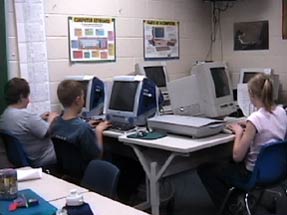Project Goals
THE BIG GOAL of this project is to enable New Hampshire teacher education
programs to prepare new teachers to use technology effectively. Project
support is, therefore, focused on these objectives:
- Faculty need to be comfortable using technology.
- Courses and programs at each institution need to be aligned to national
technology standards (NETS-T) and to NH credential and program standards.
- IHE programs participate, as appropriate, in research related to project
goals.
 |
PHOTO: Mentor teacher Beth Haarlander's students at
North Londonderry Elementary School use a spreadsheet application to
create line graphs, as part of a multi disciplinary unit on the Iditarod
Dog Sled Race. |
| PHOTO: Dr. Lynn Davis introduces her students at Plymouth
State College to Thinking Maps processes through paper and pencil exercises
before having them use the Thinking Maps software to practice applying
the maps to simple problems posed by the instructor. |
 |
1. FACULTY PROFESSIONAL DEVELOPMENT
- Each IHE ensures that a “basic training” program is or
has been developed on site to deliver faculty’s basic tech skills.
- Each IHE identifies a core group of faculty to attend PT3 content sessions
at their own campus.
- Each IHE identifies a digital video team (one or more teams) to attend
DV training and produce video vignettes with accompanying materials. One
or more K12 mentor teachers are identified by each IHE as team members.
- Each IHE utilizes additional professional development resources offered
through the project, such as the Christa McAuliffe and Classroom Connect
Conferences, and other funds for conference and workshop opportunities.
- NHDOE coordinates the development of an online resource area of the
project web site with information about programs, standards, research,
and practices.
2. COURSE ALIGNMENT TO NETS-T
- Each IHE program uses published research on technology integration
to inform classroom practice and program alignment.
- Each IHE program works with one or more K12 partners to explore practical
classroom applications of the NETS. Collaboration includes DV exhibit
creation, site visits to K12 classrooms, virtual visits, online dialogue
with K12 mentor teachers, use of online resources such as NHEON, and K12
visits to IHEs.
- Each IHE identifies one or more digital video teams to attend DV training
and produce video vignettes with accompanying materials for use in teacher
preparation courses.
- Each IHE produces a progress report
of the NETS-T course redesign and alignment work that has taken place
to date.
- Each IHE schedules half day sessions in the fall and spring terms for course
alignment work on campus. To create maximum program impact for the
future of each
IHE’s teacher preparation program, all education faculty should
be encouraged to participate in this work. Apple consultants are available
through the project to facilitate this work.
- NHDOE coordinates the development of an online resource area of the
project web site with information about programs, standards, research,
and practices.
| PHOTO: Mentor teacher Claudia Spangler created an
integrated unit of study called "NH Animal ABC's" for her
grade one class at Bow Elementary School. The purpose of the lesson
was for students to be able to demonstrate their knowledge of NH animals
as they write, illustrate and publish an "online" animal alphabet
book. |
 |
3. RESEARCH PROJECTS
- Research proposals related to technology implementation are
submitted to NHDOE each project year for funding consideration.
- Research
findings from funded research projects are posted on the project’s
public web site, presented at state and national conferences, and are submitted
for
publication(s).
- NHDOE coordinates the development of an online resource area of the
project web site with information about programs, standards, research,
and practices.
 back
to top
back
to top



